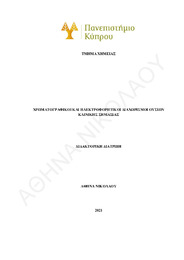Χρωματογραφικοί και ηλεκτροφορητικοί διαχωρισμοί ουσιών κλινικής σημασίας

View/
Date
2021Publisher
Πανεπιστήμιο Κύπρου, Σχολή Θετικών και Εφαρμοσμένων Επιστημών / University of Cyprus, Faculty of Pure and Applied SciencesPlace of publication
ΚύπροςGoogle Scholar check
Keyword(s):
Metadata
Show full item recordAbstract
Ο πρωταρχικός στόχος της παρούσας διδακτορικής έρευνας είναι η χρήση χειρόμορφων ιοντικών υγρών, τα οποία έχουν ως βάση τους εστέρες των αμινοξέων (Amino Acid Ester-based Ionic Liquids, AAILs), σε συνδυασμό με μια νέα τάξη χειρόμορφων επιλογέων (Chiral Selectors, CSs), τις κυκλοφρουκτάνες (Cyclofructans, CFs), για τον εναντιομερή διαχωρισμό της θυροξίνης (T4), της νεφοπάμης (NEF), της σετιριζίνης (CTZ) και της φεξοφεναδίνης (FXD) με τη μέθοδο της ηλεκτροκινητικής χρωματογραφίας τριχοειδούς (Electrokinetic Chromatography, EKC).
Αρχικά, μελετήθηκαν διάφορες φυσικές CFs και κυκλοδεξτρίνες (Cyclodextrins, CDs), καθώς επίσης και τα παράγωγά τους. Ανάμεσα στις CFs που μελετήθηκαν, ξεχωριστή θέση στην εναντιοεκλεκτικότητα ως προς τα εξεταζόμενα φάρμακα, κατέκτησε η θειική κυκλοφρουκτάνη 6 (Sulfated Cyclofructan 6, SCF6), η οποία διακρίθηκε για την αποτελεσματικότητα της στη χειρόμορφη ανάλυση των ουσιών NEF και FXD. Στη συνέχεια, συντέθηκαν τα L- και D- εναντιομερή ενός ΑΑIL και μελετήθηκε η εναντιοεκλεκτική τους ικανότητα. Για σκοπούς μελέτης της πιθανής συνεργιστικής τους δράσης με τις CFs, επιλέχθηκε το L- εναντιομερές, του γαλακτικού τερτ- βουτυλεστέρα της L-αλανίνης (L-Alanine tert-butyl ester Lactate, L-AlaC4Lac).
Στο επόμενο στάδιο της διδακτορικής μελέτης, επιχειρήθηκε για πρώτη φορά, ο ποιοτικός και ποσοτικός προσδιορισμός της κύριας ψυχοδραστικής ένωσης της κάνναβης, της Δ9-τετραϋδροκανναβινόλης (Δ9-tetrahydrocannabinol, THC), και των μεταβολιτών της, σε ένα μη συνηθισμένο βιολογικό δείγμα, στις κυψελίδες αυτιού (κερί) με τη χρήση της μεθόδου υγρής χρωματογραφίας υπερύψηλης απόδοσης σε σύζευξη με διαδοχική φασματομετρία μαζών (Ultra Pressure Liquid Chromatography tandem Mass Spectrometry, UPLC-MS/MS). Πρωτίστως, περιγράφονται τα στάδια ανάπτυξης και αξιολόγησης της αναλυτικής μεθόδου στο σύστημα UPLC-MS/MS, με τον προσδιορισμό και τη βελτιστοποίηση, τόσο των χρωματογραφικών όσο και των φασματοσκοπικών παραμέτρων. Επιτεύχθηκε ο διαχωρισμός όλων των κανναβινοειδών ενώσεων που εξετάστηκαν σε αυτή την εργασία, συμπεριλαμβανομένων της κανναβιδιόλης (Cannabidiol, CBD) και της THC, οι οποίες παρουσίασαν, εκτός από την ίδια μοριακή μάζα και πανομοιότυπα μοτίβα θραυσματοποίησης. Η μέθοδος αξιολογήθηκε μέσω της γραμμικότητας και των ορίων ανίχνευσης και ποσοτικοποίησης.
Το πιο σημαντικό και συνάμα το πιο κρίσιμο στάδιο της διδακτορικής αυτής έρευνας αποτέλεσε ο προσδιορισμός και η αξιολόγηση της πειραματικής μεθόδου επεξεργασίας αυτού του ασυνήθιστου βιολογικού δείγματος. Η αποδοτικότητα της εκχύλισης των πέντε κανναβινοειδών από την εξεταζόμενη μήτρα υπολογίστηκε μέσω των πειραμάτων ανάκτησης, της επίδρασης του υλικού της μήτρας και του φαινομένου «Carryover».
Τελικός στόχος αποτέλεσε η διερεύνηση της εφαρμοσιμότητας των αναπτυχθέντων μεθοδολογιών, τόσο της ανάλυσης στο σύστημα UPLC-MS/MS όσο και της επεξεργασίας των δειγμάτων. Η πρωτότυπη μέθοδος εφαρμόστηκε σε πραγματικά δείγματα κεριού που λήφθηκαν από χρήστες κάνναβης. Στο στάδιο αυτό επιτεύχθηκε, για πρώτη φορά, η ανίχνευση της κύριας ψυχοτρόπου ένωσης της κάνναβης, της THC, καθώς επίσης και της CBN στις κυψελίδες αυτιού. Επίσης, για πρώτη φορά, πραγματοποιήθηκε ποσοτικοποίηση αυτών των ενώσεων σε δείγματα κεριού. The primary goal of the present doctoral thesis is the chiral analysis of clinically important compounds by employing chiral selectors (CSs) in Capillary Electrophoresis (CE). In this study, a new CE method was developed, employing a binary system of a CS, either a cyclodextrin (CD) or a cyclofructan (CF), and a chiral ionic liquid (CIL). In particular, the enantioseparations of thyroxine (T4), nefopam (NEF), cetirizine (CTZ) and fexofenadine (FXD) were examined. Emphasis was laid on establishing a binary system of a native CF, or derivatives, along with the CIL for the resolution of the enantiomeric pairs.
Parameters, such as the type of the CS, the concentration of both the CS and CIL, and the BGE’s pH and type, were methodically examined, to optimize the chiral separation of each analyte. It was observed that, in some cases, the addition of the CIL into the BGE improved both resolution and efficiency significantly. Examination of the CILs (both L- and D- enantiomers), as the sole CSs did not provide any enantio-resolution for the analytes under study.
After the optimization of separation conditions, baseline separations of NEF and FXD were achieved in less than 5 min. On the contrary, for the drugs CTZ and T4, only a peak splitting was observed.
The main objective of this doctoral study, as described in the second part of the thesis, is the analysis of cerumen, commonly known as earwax, for the detection of cannabis. Cerumen, a non-conventional biological secretion, that is yet very little exploited as a forensic specimen, is proposed as an alternative matrix for forensic analysis, especially for the detection of phytocannabinoids.
A fully validated analytical Ultra Performance Liquid Chromatography - tandem Mass Spectrometry (UPLC-MS/MS) method was developed for the detection and quantification of the most prevalent psychoactive illicit drug globe wide, commonly referred to as THC (Δ9-tethrahydrocannacinol), along with two metabolites and two major cannabinoids found in Cannabis Sativa. Chromatographic separation of all five cannabinoids under study were chromatographically resolved within 5 min.
The most laborious challenge of this doctoral research was the establishment of the extraction procedure of cannabinoids. After examining various extraction solvents, the optimum, regarding the extraction efficiency, for all analytes was selected. All evaluation parameters, including precision, accuracy, matrix effect, extraction recoveries and carryover effect, were determined and were found to be within acceptable limits. The developed extraction method enabled minimum total analysis time and good recoveries (79-91%) for all phytocannabinoids under study. Additionally, no matrix effect nor carryover was observed.
To prove applicability of the proposed assay, volunteers were selected, and their cerumen samples were examined, for cannabis. All samples were analysed by using the developed UPLC-MS/MS method, and they were all tested positive to cannabis. Surprisingly, both THC and Cannabinol (CBN) were detected, and quantification was performed in three out of the four samples. To the best of our knowledge, detection of the psychoactive THC was achieved for the first time in this biological specimen, indicating recent cannabis abuse, in accordance with self-reports from the volunteers.
Collections
Cite as
The following license files are associated with this item:

